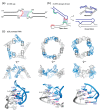Structural Insights into RNA Dimerization: Motifs, Interfaces and Functions
- PMID: 32585844
- PMCID: PMC7357161
- DOI: 10.3390/molecules25122881
Structural Insights into RNA Dimerization: Motifs, Interfaces and Functions
Abstract
In comparison with the pervasive use of protein dimers and multimers in all domains of life, functional RNA oligomers have so far rarely been observed in nature. Their diminished occurrence contrasts starkly with the robust intrinsic potential of RNA to multimerize through long-range base-pairing ("kissing") interactions, self-annealing of palindromic or complementary sequences, and stable tertiary contact motifs, such as the GNRA tetraloop-receptors. To explore the general mechanics of RNA dimerization, we performed a meta-analysis of a collection of exemplary RNA homodimer structures consisting of viral genomic elements, ribozymes, riboswitches, etc., encompassing both functional and fortuitous dimers. Globally, we found that domain-swapped dimers and antiparallel, head-to-tail arrangements are predominant architectural themes. Locally, we observed that the same structural motifs, interfaces and forces that enable tertiary RNA folding also drive their higher-order assemblies. These feature prominently long-range kissing loops, pseudoknots, reciprocal base intercalations and A-minor interactions. We postulate that the scarcity of functional RNA multimers and limited diversity in multimerization motifs may reflect evolutionary constraints imposed by host antiviral immune surveillance and stress sensing. A deepening mechanistic understanding of RNA multimerization is expected to facilitate investigations into RNA and RNP assemblies, condensates, and granules and enable their potential therapeutical targeting.
Keywords: RNA; dimerization; domain swapping; folding; intermolecular interaction; riboswitches; ribozymes; structure.
Conflict of interest statement
The authors declare no conflict of interest.
Figures






Similar articles
-
The molecular interactions that stabilize RNA tertiary structure: RNA motifs, patterns, and networks.Acc Chem Res. 2011 Dec 20;44(12):1302-11. doi: 10.1021/ar200098t. Epub 2011 Sep 7. Acc Chem Res. 2011. PMID: 21899297
-
An RNA folding motif: GNRA tetraloop-receptor interactions.Q Rev Biophys. 2013 Aug;46(3):223-64. doi: 10.1017/S0033583513000048. Epub 2013 Aug 5. Q Rev Biophys. 2013. PMID: 23915736 Review.
-
An in vitro-selected RNA receptor for the GAAC loop: modular receptor for non-GNRA-type tetraloop.Nucleic Acids Res. 2013 Apr 1;41(6):3748-59. doi: 10.1093/nar/gkt040. Epub 2013 Feb 4. Nucleic Acids Res. 2013. PMID: 23382175 Free PMC article.
-
Comprehensive features of natural and in vitro selected GNRA tetraloop-binding receptors.Nucleic Acids Res. 2008 Mar;36(4):1138-52. doi: 10.1093/nar/gkm1048. Epub 2007 Dec 23. Nucleic Acids Res. 2008. PMID: 18158305 Free PMC article.
-
Discriminating Self and Non-Self by RNA: Roles for RNA Structure, Misfolding, and Modification in Regulating the Innate Immune Sensor PKR.Acc Chem Res. 2016 Jun 21;49(6):1242-9. doi: 10.1021/acs.accounts.6b00151. Epub 2016 Jun 8. Acc Chem Res. 2016. PMID: 27269119 Free PMC article. Review.
Cited by
-
RNA: The Unsuspected Conductor in the Orchestra of Macromolecular Crowding.Chem Rev. 2024 Apr 24;124(8):4734-4777. doi: 10.1021/acs.chemrev.3c00575. Epub 2024 Apr 5. Chem Rev. 2024. PMID: 38579177 Free PMC article. Review.
-
Three-Color Imaging Enables Simultaneous Screening of Multiple RNA Targets on Small Molecule Microarrays.Curr Protoc Chem Biol. 2020 Dec;12(4):e87. doi: 10.1002/cpch.87. Curr Protoc Chem Biol. 2020. PMID: 33275330 Free PMC article.
-
Rational engineering enables co-crystallization and structural determination of the HIV-1 matrix-tRNA complex.STAR Protoc. 2021 Dec 22;3(1):101056. doi: 10.1016/j.xpro.2021.101056. eCollection 2022 Mar 18. STAR Protoc. 2021. PMID: 35005638 Free PMC article.
-
Decryption of sequence, structure, and functional features of SINE repeat elements in SINEUP non-coding RNA-mediated post-transcriptional gene regulation.Nat Commun. 2024 Feb 21;15(1):1400. doi: 10.1038/s41467-024-45517-3. Nat Commun. 2024. PMID: 38383605 Free PMC article.
-
RNA Granules: A View from the RNA Perspective.Molecules. 2020 Jul 8;25(14):3130. doi: 10.3390/molecules25143130. Molecules. 2020. PMID: 32650583 Free PMC article. Review.
References
Publication types
MeSH terms
Substances
Grants and funding
LinkOut - more resources
Full Text Sources

